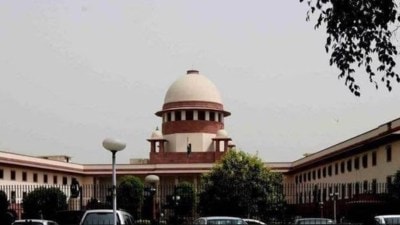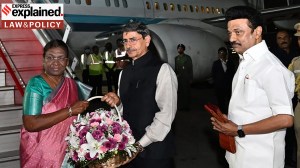Women MPs’ contribution has increased in Parliament. Data proves it
Female MPs from the ruling party are asking more questions, have demonstrated a significantly higher level of scrutiny towards their own government, and hold their ministries accountable
 The central question is whether women MPs, regardless of their political alignment, possess the same empowerment as their male counterparts when it comes to questioning the government during parliament sessions. (Reprsentational Image)
The central question is whether women MPs, regardless of their political alignment, possess the same empowerment as their male counterparts when it comes to questioning the government during parliament sessions. (Reprsentational Image) Extensive coverage has been dedicated to the policies implemented by the Narendra Modi government that have had a substantial positive impact on women across the country. These encompass the benefits arising from increased accessibility to LPG cooking fuel, which has significantly improved women’s health and well-being, as well as the implications of enhanced toilet accessibility on the health and safety of women.
Furthermore, the fact that a majority of the beneficiaries of the Pradhan Mantri Jan Dhan Yojana are women account holders, and very crucially, ownership of houses under PM Awas Yojana is with women heads of families, has further contributed to the economic empowerment of women across India. There are also “silent revolutions” quietly taking place that have received relatively little attention. Among these, we examine the achievements and contributions of women leaders in India’s Parliament in recent years.
The primary role of leaders in a democratic system is to represent the interests of their constituents and advocate for government accountability. Consequently, a crucial aspect of parliamentary democracy is that elected members of Parliament (MPs) must question the government, irrespective of their political affiliation, caste, gender, and so on. This practice serves as a check on government power and ensures that the government remains accountable to the will of the people. While conventional methods for assessing women’s political empowerment have been limited to counting the number of women in Parliament and legislative assemblies, our approach involves evaluating their participation in both houses compared to their male counterparts. The central question is whether women MPs, regardless of their political alignment, possess the same empowerment as their male counterparts when it comes to questioning the government during parliament sessions.
The political empowerment of women plays a vital role in reinforcing civil and human rights (United Nations 2011). In this context, scholarly research, both globally and within the Indian context, has predominantly focused on disparities in the representation of women in Parliament, the impact of women as political leaders on societal outcomes, and the increasing influence of women voters, which we originally referred to as a “silent revolution” in India in our writings more than a decade back. Today, these are well-recognised and widely appreciated phenomena across political circles. However, there has hardly been any discussion regarding whether a female political leader elected as an MP has the authority to raise concerns on behalf of her constituents who are often from marginalised sections of society such as women and children. In fact, the commonly held belief is that women MPs have limited voice and meekly follow their party line on the floor of the House.
So how do women MPs perform compared to their male counterparts? To conduct our analysis, we utilised publicly available data from the 15th Lok Sabha (from May 18, 2009, to May 18, 2014) and the 16th Lok Sabha (from May 18, 2014, to May 23, 2019) obtained from PRS Legislative Research (PRS). This data tracks comprehensive information about the activities of MPs in the Lok Sabha and the Rajya Sabha, including their gender, age, state, constituency, political party affiliation, attendance in Parliament sessions, the number of questions asked, participation in debates, and the introduction of private members bills. Our primary focus was on the number of questions raised by MPs, and we compared the median number of questions asked by MPs based on gender and political affiliation (Bharatiya Janata Party vs Indian National Congress).
During the 15th Lok Sabha, there were 64 women MPs, with 14 belonging to the BJP (approximately 12 per cent of BJP MPs) and 25 from the Indian National Congress (approximately 12 per cent of INC MPs). In the 16th Lok Sabha, there were 68 women MPs, with 32 from the BJP (around 11 per cent of BJP MPs) and only four from the INC (8 per cent of INC MPs).
Our findings reveal (Figure 1) that during the 15th Lok Sabha, women MPs asked significantly fewer questions than their male counterparts (135 versus 250). However, in a remarkable contrast, their level of engagement in the 16th Lok Sabha was on par with male MPs (218 versus 219).
A closer examination of these results based on the party affiliations of women MPs reveals a striking trend. Specifically, the median number of questions raised by women MPs from the BJP, the leading opposition party in the 15th Lok Sabha, was 355. In contrast, the median number of questions asked by female MPs from the INC, the leading ruling party in the 15th Lok Sabha, was merely 58.
The most remarkable finding from this analysis, however, is that after the assumption of power by the BJP in the 16th Lok Sabha, female MPs from the BJP posed the most substantial number of questions (346) to their own government. An essential implication drawn from these findings is that there is an underlying empowerment and encouragement of female MPs within the BJP, particularly under the leadership of Prime Minister Modi, when it comes to their engagement in the Parliament. Female MPs from the ruling party have demonstrated a significantly higher level of scrutiny towards their own government, holding their own ministries accountable.
Another lesser-known fact is that women MPs focus on issues which are fundamentally distinct from their male counterparts. As the evidence shows (Figure 2), female MPs focus particularly on critical matters of healthcare, education, roads, and micro, small, and medium-sized enterprises (MSMEs) which affect the most vulnerable segment of our society; whereas male MPs mostly focus on finance, defence, external affairs, the prime minister’s office etc. These are extraordinary features of the political state of affairs in India today and auger well for the future of this great nation as it braces women-led democracy with the historic women’s reservation bill.
The writer is Member, Economic Advisory Council to the Prime Minister
Photos




- 01
- 02
- 03
- 04
- 05



























